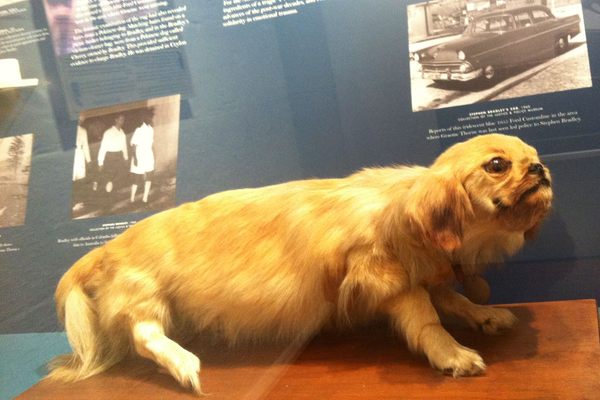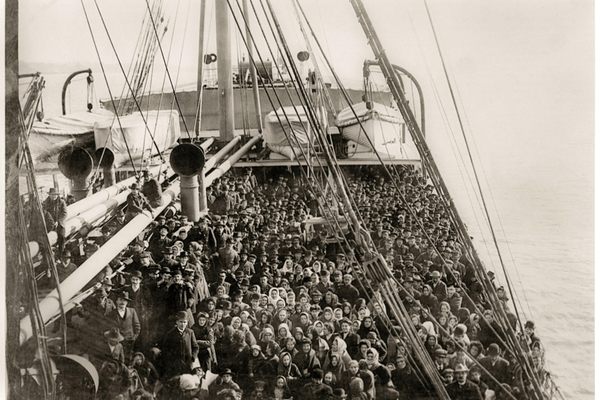Objects of Intrigue: Napoleon’s Last Horse
Napoleon’s horse Vizir (photograph by the author)
Almost hidden away inside a glass cabinet in one of the more obscure hallways of the Musée de l’Armée in Paris is a small taxidermy horse, a crack running down its shoulder like a fault line. These are the remains of Vizir, Napoleon Bonaparte’s grey Arabian stallion that accompanied the deposed emperor to Elba.
Vizir was hardly Napoleon’s only horse. According to the Musée de l’Armée, over the 14 years of Napoleon’s reign he used 130 horses (here’s a rambling list of them). And the stallion wasn’t Napoleon’s most famous horse either, that would go to Marengo, a charger who served and was captured at Waterloo, his skeleton still a British trophy at the Imperial War Museum in London. But Vizir was the last horse to keep Napoleon company out in exile, and now serves as the only taxidermy reminder of all his fellow steeds employed by Napoleon in his rise and fall from power.
Painting of Le Vizir by Pierre Martinet (via Musées de France)
Jacques-Louis David, “Napoleon Crossing the Alps” (1802-03), oil on canvas (via Kunsthistorisches Museum)
Napoleon preferred small, spry horses, rather than the thoroughbreds favored by his officers, although not because of his stature (his low height is mostly a myth anyway). Rather, he just wasn’t a terribly great horseman. Not having grown up wealthy in Corsica, he didn’t start riding until his military career. Yet later he would pose on horseback in his most famous portraits, such as the famous 1803 painting of “Napoleon Crossing the Alps” by Jacques-Louis David (believed to depict Marengo) where man and horse rear up on a stormy, mountainous landscape, his red cape flowing like the horse’s mane. The paintings suggest a fierce pride in both his power and that of the animals he rode.
As for Vizir, he was a friendship gift from the Sultan of the Ottoman Empire. As far as it’s known, Vizir is the only one of Napoleon’s horses to end up in taxidermy, and he spent some time in a museum in Manchester before arriving at the Louvre in 1868, being forgotten in the attic for a time, and then transported to the Musée de l’Armée after the War of 1870. This was, of course, a few decades after Vizir’s death, so how were they sure it was him? A brand on the horse’s haunches bears an “N” topped with a crown.
Brand on Vizir (photograph by the author)
Archive photograph of “le Vizir” with Napoleon’s dog (via napoleon.org)
The Musée de l’Armée offers a careful bit of doubt in their take on the story — stating “si c’est bien lui,” “if it’s indeed him” — but from most accounts the monogrammed horse was long ago the last equine companion of Napoleon. He’s shrunk down a bit from botched restorations, and the taxidermy dog who accompanied Napoleon on Saint Helena and once stood alongside Vizir in the museum now seems to have been removed from display. Yet even in his shoddy state, his fur worn down in places to the tanned skin, his glass case unglamorously positioned by a museum restroom, Vizir is just a few minutes walk from the grand tomb of Napoleon himself at les Invalides. Even in death, Vizir remains the closest final animal companion of the once-emperor.
Vizir in his glass case
Vizir in the hallway of the Musée de l’Armée
For more brave animals preserved in taxidermy, check out our Guide to Taxidermy Heroic Animals.
Objects of Intrigue is a feature highlighting extraordinary objects from the world’s great museums, private collections, historic libraries, and overlooked archives. See more incredible objects here >


















Follow us on Twitter to get the latest on the world's hidden wonders.
Like us on Facebook to get the latest on the world's hidden wonders.
Follow us on Twitter Like us on Facebook